
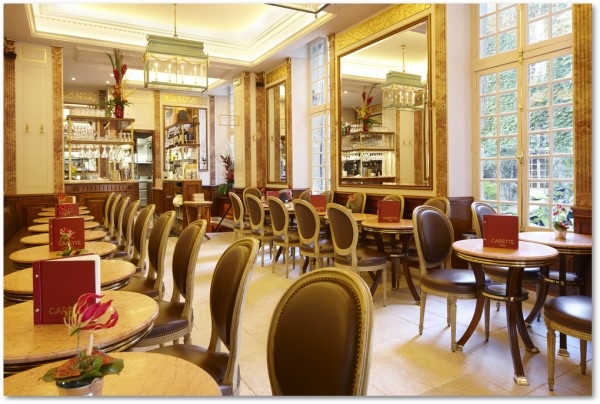
Parismarais
Newsletter
Issue 62 december 2010
http://www.parismarais.com
"BONNES FÊTES” AND “MEILLEURS VŒUX"
Bonjour Parismarais readers,
 Paris might just be one of the most magical places to celebrate
Christmas, provided that you plan ahead. In France, Christmas is for
families and just about everyone stays in on Christmas Eve to feast
on oysters, foie gras, turkey and trimmings, followed by the
traditional dessert: a bûche de Noël (log-shaped Christmas cake).
The commercial world shuts down. Christmas Day is a quiet day of
relaxation with the family. ( Check the ones made by La Fougasse : http://www.parismarais.com/gastronomic-treasures.htm Paris might just be one of the most magical places to celebrate
Christmas, provided that you plan ahead. In France, Christmas is for
families and just about everyone stays in on Christmas Eve to feast
on oysters, foie gras, turkey and trimmings, followed by the
traditional dessert: a bûche de Noël (log-shaped Christmas cake).
The commercial world shuts down. Christmas Day is a quiet day of
relaxation with the family. ( Check the ones made by La Fougasse : http://www.parismarais.com/gastronomic-treasures.htm
 So what can a tourist do in Paris on this stay-at-home day? That’s
where the planning comes in. To get you in the mood, Handel’s
Messiah will be performed at the Eglise de la Madeleine on December
22. Christmas Eve is a great time to window shop on the
Champs-Elysées, with its spectacular Christmas illuminations, or
check out the animated window displays at the grands magasins –
Galeries Lafayette, Le Printemps, Le Bon Marché and BHV – without
the crowds. Another free activity on Christmas Eve is the awe-inspiring
spectacle of midnight mass at Notre Dame Cathedral (arrive an hour
or two ahead of time to be sure you get a seat). So what can a tourist do in Paris on this stay-at-home day? That’s
where the planning comes in. To get you in the mood, Handel’s
Messiah will be performed at the Eglise de la Madeleine on December
22. Christmas Eve is a great time to window shop on the
Champs-Elysées, with its spectacular Christmas illuminations, or
check out the animated window displays at the grands magasins –
Galeries Lafayette, Le Printemps, Le Bon Marché and BHV – without
the crowds. Another free activity on Christmas Eve is the awe-inspiring
spectacle of midnight mass at Notre Dame Cathedral (arrive an hour
or two ahead of time to be sure you get a seat).
 In the run-up to the holidays, Christmas markets, based on the model
of the famous markets in Nuremberg and Munich, Germany, and
Strasbourg, France, are held in the Jardins du Trocadéro (across
from the Eiffel Tower), the Place Saint Germain des Prés, Place
Saint-Sulpice, the Gare Saint-Lazare, and the Champs-Elysées between
Concorde and the Rond-Point des Champs-Elysées. In the run-up to the holidays, Christmas markets, based on the model
of the famous markets in Nuremberg and Munich, Germany, and
Strasbourg, France, are held in the Jardins du Trocadéro (across
from the Eiffel Tower), the Place Saint Germain des Prés, Place
Saint-Sulpice, the Gare Saint-Lazare, and the Champs-Elysées between
Concorde and the Rond-Point des Champs-Elysées.
Families with kids might want to visit the magical Doll
Museum or the even more magical Museum of Magic, both
located in the Marais. On Christmas Day, take the family ice skating
on the Eiffel Tower or on the rink in front of the Hôtel de Ville.
 For Grinches who hate Christmas, it’s a great time to catch up on
films you haven’t gotten around to seeing or hang out at a trendy
café like the Café Charlot in the Marais. Or treat yourself to dinner on a
Bateau Mouche… (See also the restaurants open on Christmas Day :
http://www.parismarais.com/selected-restaurants.htm) or a sexy show
at the Crazy Horse. Or just have tea at Carette, the chic new
tearoom on the Place des Vosges (pictured above). For Grinches who hate Christmas, it’s a great time to catch up on
films you haven’t gotten around to seeing or hang out at a trendy
café like the Café Charlot in the Marais. Or treat yourself to dinner on a
Bateau Mouche… (See also the restaurants open on Christmas Day :
http://www.parismarais.com/selected-restaurants.htm) or a sexy show
at the Crazy Horse. Or just have tea at Carette, the chic new
tearoom on the Place des Vosges (pictured above).
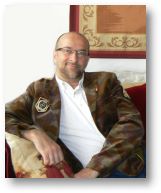
|
Whatever you
do, have a wonderful holiday.
See below for information on hotels – including new additions to
the Parismarais stable – apartment rentals and exciting events
in Paris.
Bonne fêtes!
Pascal Fonquernie
Editor, Parismarais.com |
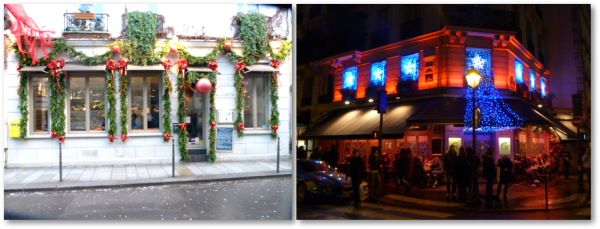
Restaurant les Gars dans la Cuisine & L'Open Café open on Christmas
week
HOLIDAY RENTALS
Last minute opportunities for X-mas and New Year’s week with
Parismarais
Starting at 100 euros per night, with a a minimum stay of one
week, you can afford to live in a private apartment and enjoy 4-star
standards.... in 2011 ParisMarais.com will also offer the
possibility of long-term rentals, from 3 months to one year. These
are fabulous, full-serviced apartments in historical Marais
buildings.
Check the Medieval Suite page: some apartments are still free at the
last minute as well as for medium-term rental from mid-January.
http://www.parismarais.com/medieval-suite.htm
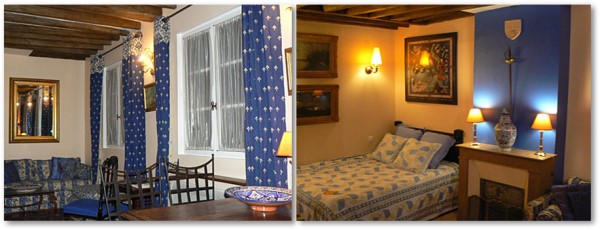
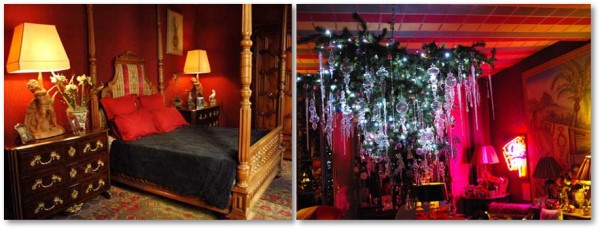 The Marais House The Marais House
And
The Marais Guesthouse, the most luxurious place you can find in Le
Marais, is also on the same page. Don’t forget to check the elegant
hotel Le Pavillon de la Reine **** . They still have a few rooms
left for X-mas week.
http://www.parismarais.com/4-star-hotels-paris-marais.htm
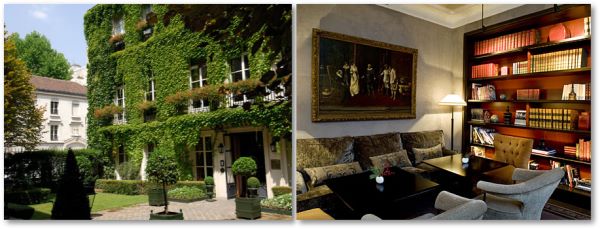 Le Pavillon de la Reine, after it’s renovation Le Pavillon de la Reine, after it’s renovation
SHORT-TERM RENTALS: know the truth and book with French licenced agencies.
What should you know about short-term rentals? The rules are strict
and will be become even more strict in the next year. Many American
websites suggest you invest in Paris apartments that can be rented
weekly to tourists, and they promise you the moon. It was certainly
a great idea 10 years ago, but not any more. The market is totally
saturated and Parisians cannot even find places to live for
themselves. This is not a good money-making proposition since there
are far too many offers on the market. In fact, the Paris Mayor has
decided to fight against illegal agencies, mostly based in USA,
Russia and fiscal paradises such as Delaware or some tropical
islands… read our warning on this page and trust the residents.
Unless you plan to live here over 6 months per year, you will find
yourself in an illegal situation and put yourself at enormous risk
as a foreigner. Paris real estate has never been so expensive,
nearly 12 000 euros per square meter in le Marais, + around 8%
administration and tax fees to the “notaire”. So you’ll never get a
return on your investment. Moreover, when you resell your property,
as a foreign owner, you will be taxed at 33% on your potential
profits. So unless you live here over 6 months per year, our advice
is not to buy, but to rent and only with French-based agencies or
private owners who respect strict the rules and are members of Paris
Tourist Office.
Read
more on: http://www.parismarais.com/rent-a-flat.htm
BRAND NEW HOTELS ON THE EDGE OF THE MARAIS ARE JOINING OUR NETWORK
THE
4-STAR CROWNE PLAZA HOTEL AT PLACE REPUBLIQUE AND 3-STAR
MARAIS-BASTILLE HOTEL
soon online at the best prices online with parismarais.com…
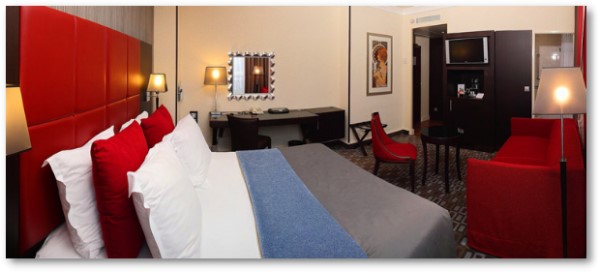
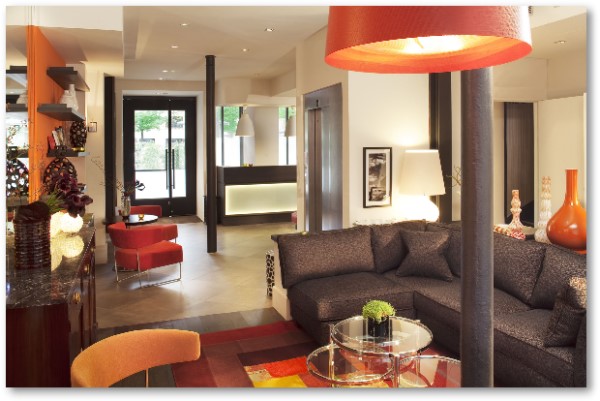
ARTS & CULTURE : MONDRIAN AT THE GEORGES POMPIDOU CENTER
The
mystery surrounding the work of Piet Mondrian (1872-1944) is only
deepened by “Mondrian/De Stijl,” the excellent exhibition that opens
today at the Centre Pompidou: how did Mondrian’s name become an
international synonym for abstract, geometric arrangements of black
strips and blocks of primary color and how could paintings that are
so emotionless touch so many people so deeply and lastingly?
The main lesson of the exhibition is that Mondrian did not spring
fully formed into life as the artist known as Mondrian. He spent
years experimenting with styles originated by other artists –
Symbolism, Impressionism, Fauvism, Cubism, etc. – before finally
settling on his orderly formula of black grids with blocks of
primary color, which he called Neo-Plasticism, meant to “link
pictorial order with a social, spiritual and poetic utopia,” and
sticking with it for pretty much the rest of his life.
The exhibition firmly places Mondrian’s work in perspective (notably
lacking in his paintings). It starts by focusing on the
philosophical basis for the De Stijl (The Style) movement: theosophy,
a belief popular in the early 20th century, which held that the
universe is underpinned by geometrical principles applicable to all
cultures. Members of the De Stijl movement sought a “universal and
rational pictorial language” to illustrate it.
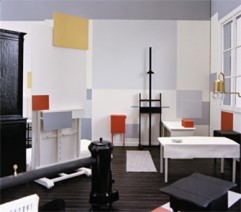 Works by a number of the artists involved in the movement, notably
Theo Van Doesburg, who invited Mondrian to help him launch the De
Stijl journal in 1917, show them trying to represent the inner mind
visually. Some of Mondrian’s attempts at the exercise seem gauche,
such as “Dune Landscape” (1911), while others, like the Fauvist,
nearly abstract “Red Cloud” (1907-09), are more successful. Works by a number of the artists involved in the movement, notably
Theo Van Doesburg, who invited Mondrian to help him launch the De
Stijl journal in 1917, show them trying to represent the inner mind
visually. Some of Mondrian’s attempts at the exercise seem gauche,
such as “Dune Landscape” (1911), while others, like the Fauvist,
nearly abstract “Red Cloud” (1907-09), are more successful.
Already well into his 30s, Mondrian moved on, trying other styles as
they came along. The exhibition presents a very clear progression of
his work through all the various styles, surrounded by works by
other, now-lesser-
known artists who were experimenting with the
same themes. We see Mondrian’s work respond to each movement,
reacting especially strongly to the introduction of Cubism by
Picasso and Braque, first with a rather lame attempt, then with more
interesting and original works.
Cubism was a liberating force for Mondrian, offering him a way of
seeing painting as no longer a means of individual expression or of
depicting an object, but as a way of organizing space. Already, in
conformity with theosophical theory, lines were ordering and giving
rhythm to his paintings even when they were still figurative, as in
his many experiments with images of trees, which became increasingly
abstract until he finally started getting to the essence: geometry
and pure color.
It took some time, however, before he reduced his works to grids and
his palette to black, white and the three primary colors – a few
rooms in the show are filled with abstract, geometric pieces from
the late 1920s that still incorporate grays, pastel colors and fuzzy
lines.
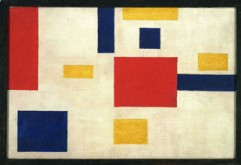 This mega-show, which concentrates on Mondrian’s Paris years, from
1912 to ’38, offers only a handful of works from his mature period,
and it must not be forgotten that he came to his “Mondrian” style
rather late in life, when he was in his 50s. It is interesting to
note that the artist really struggled with and worked at these
paintings, which can seem so reductive and formulaic: an unfinished
canvas dating from 1934 shows how he kept changing his mind and
moving the lines and blocks of color as he worked. This mega-show, which concentrates on Mondrian’s Paris years, from
1912 to ’38, offers only a handful of works from his mature period,
and it must not be forgotten that he came to his “Mondrian” style
rather late in life, when he was in his 50s. It is interesting to
note that the artist really struggled with and worked at these
paintings, which can seem so reductive and formulaic: an unfinished
canvas dating from 1934 shows how he kept changing his mind and
moving the lines and blocks of color as he worked.
The music-loving Mondrian later introduced double and interlaced
lines to his work, giving them a new rhythm and dynamism. The jazz-influenced
“Boogie-Woogie” paintings (unfortunately, not in the show) done in
New York near the end of his life, took a new direction, using
rectangles of color rather than lines, and seem livelier and more
human than his strict earlier works. Throughout his career, however,
he never lost sight of the spiritual intention of his art: the
colors were meant to absorb the environment of the room and guide
the viewer toward a spiritual quest.
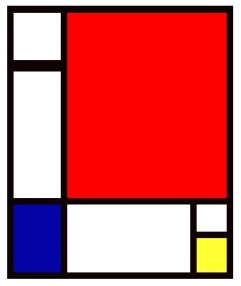 Van Doesburg is as strong a presence in this show as Mondrian, and
one can’t help but wonder why Mondrian won the eternity sweepstakes
while Van Doesburg, who quarreled with Mondrian over whether
diagonal lines should be allowed in painting, fell into relative
obscurity. A talented artist himself, Van Doesburg often led the way
for Mondrian and his other followers and seemed willing to take more
risks. Van Doesburg is as strong a presence in this show as Mondrian, and
one can’t help but wonder why Mondrian won the eternity sweepstakes
while Van Doesburg, who quarreled with Mondrian over whether
diagonal lines should be allowed in painting, fell into relative
obscurity. A talented artist himself, Van Doesburg often led the way
for Mondrian and his other followers and seemed willing to take more
risks.
The show offers glimpses into the lives of Mondrian and his De Stijl
colleagues through photographs, letters, publications and a
reconstruction of Mondrian’s Paris studio (pictured above). Probably
the neatest artist’s atelier in history, it was laid out and painted
like a Mondrian painting itself. In a series of interesting filmed
interviews of people who knew Mondrian, one notes that he was a
bachelor for a reason – “It would be impossible to live with him” –
and that the often penniless artist would sometimes compromise his
strict geometric principles to do a flower painting that he knew he
could easily sell to one of his lady collectors.
The exhibition ends with a look at the application of De Stijl
principles to other aspects of life, including architecture and
design. The goal was to turn life itself into a harmonious work of
art. The most spectacular piece is a reconstruction of the interior
of the Schröder House designed by Gerrit Rietveld. Here we see
modernity in the making, but we mustn’t forget that De Stijl was
only one of several contemporary movements – among them Russian
Constructivism and the Bauhaus – moving in similar directions.
For all his theories, was Mondrian’s art purely decorative? Can that
explain its great appeal to the masses and why it looks so
attractive when allowed to open up into architectural space, as in
his studio or his never-realized plans (included in the show) for
the decoration of a house in Dresden? Or should we simply thank Yves
Saint Laurent for appropriating Mondrian’s designs for his 1965
collection?
Heidi Ellison
http://www.paris-update.com/
Centre Pompidou: 19, rue Beaubourg, 75004 Paris. Tel.: 01 44 78 12
33.
Open 11am-9pm. Closed Tuesday.
Métro: Rambuteau. Admission: €10-€12. Through March 21, 2011.
www.centrepompidou.fr
 LE MARAIS MAP, DOWNLOAD FOR FREE! LE MARAIS MAP, DOWNLOAD FOR FREE!
To prepare for your trip to Paris, you can download the exclusive Parismarais map of le Marais for free! Be sure to print out both sides A and B of the map by clicking on the following links:
http://www.parismarais.com/map/A.pdf
http://www.parismarais.com/map/B.pdf
You can also visit the following page where you will find more maps of Paris and le Marais as well as selected places to visit—photos and addresses will “pop up” as soon as you click on the colored dots. Fabulous, n'est-ce pas?
http://www.parismarais.com/map-of-le-marais.htm
Don't miss our SPECIAL OFFERS
AOL blocks many major European ISPs, so we cannot guarantee that our mail to AOL addresses will arrive. Please use another email provider or "White List" our email address or add "info@parismarais.com" and to your contact list.
Parismarais Newsletter, december 2010
http://www.parismarais.com
mailto:info@parismarais.com
To Subscribe or unsubscribe :
http://www.parismarais.com/parismarais-newsletter.htm
To find out more about cultural events in Paris, discover Paris Update, the weekly English-language Web review of Paris cultural events edited by Heidi Ellison, an American journalist who has lived in Paris for over 20 years.
http://www.paris-update.com/fr/index.php
Follow Parismarais on Twitter:
http://www.Twitter.com/parismarais
Follow us on facebook:
https://www.facebook.com/pages/Parismarais/338587426166976
Special thanks to all our contributors and media partners all over the world.
http://www.parismarais.com/worldwide-links.htm
Should you wish to promote us and create profitable reciprocal links with us to your web site, please write to advertising@parismarais.com
PARISMARAIS.Com is a Media Partner of Paris Tourism Office, France Guide / Atout France, IGLTA and correspondant of over 100 medias in the world.
 
Copyright
2010, parismarais.comm |


 Paris might just be one of the most magical places to celebrate
Christmas, provided that you plan ahead. In France, Christmas is for
families and just about everyone stays in on Christmas Eve to feast
on oysters, foie gras, turkey and trimmings, followed by the
traditional dessert: a bûche de Noël (log-shaped Christmas cake).
The commercial world shuts down. Christmas Day is a quiet day of
relaxation with the family. ( Check the ones made by La Fougasse :
Paris might just be one of the most magical places to celebrate
Christmas, provided that you plan ahead. In France, Christmas is for
families and just about everyone stays in on Christmas Eve to feast
on oysters, foie gras, turkey and trimmings, followed by the
traditional dessert: a bûche de Noël (log-shaped Christmas cake).
The commercial world shuts down. Christmas Day is a quiet day of
relaxation with the family. ( Check the ones made by La Fougasse :  So what can a tourist do in Paris on this stay-at-home day? That’s
where the planning comes in. To get you in the mood, Handel’s
Messiah will be performed at the Eglise de la Madeleine on December
22. Christmas Eve is a great time to window shop on the
Champs-Elysées, with its spectacular Christmas illuminations, or
check out the animated window displays at the grands magasins –
Galeries Lafayette, Le Printemps, Le Bon Marché and BHV – without
the crowds. Another free activity on Christmas Eve is the awe-inspiring
spectacle of midnight mass at Notre Dame Cathedral (arrive an hour
or two ahead of time to be sure you get a seat).
So what can a tourist do in Paris on this stay-at-home day? That’s
where the planning comes in. To get you in the mood, Handel’s
Messiah will be performed at the Eglise de la Madeleine on December
22. Christmas Eve is a great time to window shop on the
Champs-Elysées, with its spectacular Christmas illuminations, or
check out the animated window displays at the grands magasins –
Galeries Lafayette, Le Printemps, Le Bon Marché and BHV – without
the crowds. Another free activity on Christmas Eve is the awe-inspiring
spectacle of midnight mass at Notre Dame Cathedral (arrive an hour
or two ahead of time to be sure you get a seat). In the run-up to the holidays, Christmas markets, based on the model
of the famous markets in Nuremberg and Munich, Germany, and
Strasbourg, France, are held in the Jardins du Trocadéro (across
from the Eiffel Tower), the Place Saint Germain des Prés, Place
Saint-Sulpice, the Gare Saint-Lazare, and the Champs-Elysées between
Concorde and the Rond-Point des Champs-Elysées.
In the run-up to the holidays, Christmas markets, based on the model
of the famous markets in Nuremberg and Munich, Germany, and
Strasbourg, France, are held in the Jardins du Trocadéro (across
from the Eiffel Tower), the Place Saint Germain des Prés, Place
Saint-Sulpice, the Gare Saint-Lazare, and the Champs-Elysées between
Concorde and the Rond-Point des Champs-Elysées.  For Grinches who hate Christmas, it’s a great time to catch up on
films you haven’t gotten around to seeing or hang out at a trendy
café like the
For Grinches who hate Christmas, it’s a great time to catch up on
films you haven’t gotten around to seeing or hang out at a trendy
café like the 


 The Marais House
The Marais House Le Pavillon de la Reine, after it’s renovation
Le Pavillon de la Reine, after it’s renovation

 Works by a number of the artists involved in the movement, notably
Theo Van Doesburg, who invited Mondrian to help him launch the De
Stijl journal in 1917, show them trying to represent the inner mind
visually. Some of Mondrian’s attempts at the exercise seem gauche,
such as “Dune Landscape” (1911), while others, like the Fauvist,
nearly abstract “Red Cloud” (1907-09), are more successful.
Works by a number of the artists involved in the movement, notably
Theo Van Doesburg, who invited Mondrian to help him launch the De
Stijl journal in 1917, show them trying to represent the inner mind
visually. Some of Mondrian’s attempts at the exercise seem gauche,
such as “Dune Landscape” (1911), while others, like the Fauvist,
nearly abstract “Red Cloud” (1907-09), are more successful. This mega-show, which concentrates on Mondrian’s Paris years, from
1912 to ’38, offers only a handful of works from his mature period,
and it must not be forgotten that he came to his “Mondrian” style
rather late in life, when he was in his 50s. It is interesting to
note that the artist really struggled with and worked at these
paintings, which can seem so reductive and formulaic: an unfinished
canvas dating from 1934 shows how he kept changing his mind and
moving the lines and blocks of color as he worked.
This mega-show, which concentrates on Mondrian’s Paris years, from
1912 to ’38, offers only a handful of works from his mature period,
and it must not be forgotten that he came to his “Mondrian” style
rather late in life, when he was in his 50s. It is interesting to
note that the artist really struggled with and worked at these
paintings, which can seem so reductive and formulaic: an unfinished
canvas dating from 1934 shows how he kept changing his mind and
moving the lines and blocks of color as he worked. Van Doesburg is as strong a presence in this show as Mondrian, and
one can’t help but wonder why Mondrian won the eternity sweepstakes
while Van Doesburg, who quarreled with Mondrian over whether
diagonal lines should be allowed in painting, fell into relative
obscurity. A talented artist himself, Van Doesburg often led the way
for Mondrian and his other followers and seemed willing to take more
risks.
Van Doesburg is as strong a presence in this show as Mondrian, and
one can’t help but wonder why Mondrian won the eternity sweepstakes
while Van Doesburg, who quarreled with Mondrian over whether
diagonal lines should be allowed in painting, fell into relative
obscurity. A talented artist himself, Van Doesburg often led the way
for Mondrian and his other followers and seemed willing to take more
risks. LE MARAIS MAP, DOWNLOAD FOR FREE!
LE MARAIS MAP, DOWNLOAD FOR FREE!
